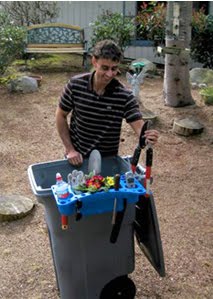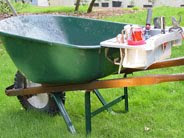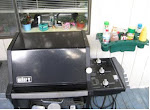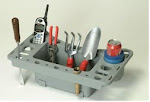Thank you to the
Gardening Guru for these great herb suggestions for your garden.
Angelica. Requires light shade and moist soil. Direct seed in the fall. It is considered a "hardy" plant and does best in cool climates. Angelica is mainly used as a condiment or confection. Roots and leaves are harvested in late summer of its second year of growth. Biennial.
Anise. Prefers a sunny location and well-drained soil. Sow seeds in the spring. It is characterized as a "half hardy" plant and requires alkaline soils. Leaves and seeds taste like licorice. Annual.
Basil. Grows well in bright light and moist soil. Propagate in the spring. It is a "tender" plant and grows well in containers. Often used in cooking from Thai recipes to Italian. Annual.
Bay. Requires light shade and well drained soil. Propagate with cuttings. Considered a "tender" plant, bay grows well in pots and is known for its leaves. Perennial.
Borage. Grows well in sunny locations and prefers dry soil. Direct seed in the spring. It is considered a hardy annual and often self-seeds. Flowers and leaves give a cucumber-like flavor to drinks. Annual.
Caraway. Select growing areas with full sun and well-drained soil. Seed in spring or fall. It is a hardy plant. Caraway seeds are aromatic and are popular in cooking and as an ingredient of liqueurs. Biennial.
Catnip. Prefers full sun and adequate moisture and well-drained soil. It should be direct seeded in the spring. Catnip can also be propagated through divisions or cuttings. It is considered a hardy plant and should be cut back in autumn. Often used for tea and is attractive to cats. Perennial.
Chervil. Requires partial shade and well drained soil. Seed in the spring. Chervil is a hardy plant and, if sown early, will self-seed. It is used as a garnish, like parsley. Annual.
Chives. Plant in partial shade and dry soil. Seed in the spring or use divisions to propagate. It is a hardy plant and will also do well indoors. Leaves provide an onion like flavor. Perennial.
Cicely. Likes growing areas with partial shade and rich soil. Seed in fall. Sweet cicely is a hardy plant that was once used as both a sugar substitute and as a furniture polish. Perennial.
Cilantro/Coriander. Grows well in sunny locations with rich, well-drained soil. Sow seeds in the spring. The leaves are known as cilantro while the seeds are called coriander. A hardy plant, this herb has a pungent taste that isn't for everyone. Popular in Thai and Mexican cooking. Annual.
Dill. Appreciates full sun and rich, well-drained soil. Seed in spring. It is best known for its use in pickling. Annual.
Fennel. Plant in sunny locations with well-drained soil. Seed in the spring or use divisions to propagate. A hardy herb, it has a faint anise fragrance. Perennial.
Horehound. Requires a sunny spot and dry, alkaline soil to grow well. Seed in the spring or use divisions or cuttings to propagate, A hardy plant, this herb is often used to flavor candy. Perennial.
Hyssop. Thrives in bright light and dry soil. Seed in the spring or use divisions or cuttings to propagate. A hardy plant, hyssop has a flavor that is slightly bitter and minty. Used to flavor liqueurs or its young leaves can be added to salad. Perennial.
Lavender. Prefers gardens with full sun and dry soil. Seed in the fall or use cuttings. Lavender is a hardy plant with fragrant leaves often used in potpourri and sachets. Perennial.
Lemon Balm. Select garden areas with partial shade and moist soil. Seed in the spring or propagate with divisions or cuttings. It is considered a hardy plant. Often used in jams, jellies and fruit salads. Perennial.
Lemon Verbena. Thrives in partial shade and well-drained soil. Direct seed in the spring or use cuttings to propagate. Lemon verbena is a semi-hardy plant that does well indoors. It adds a lemony taste to teas, cold drinks and jellies. Perennial.
Lovage. Needs light shade and a rich, moist soil to grow well. Direct seed in the fall. A hardy plant, lovage will self seed. Adds a spicy taste to dishes and is sometimes used in teas to reduce flatulence. Perennial.
Marjoram. Appreciates partial shade and rich, well-drained soil. Seed in the spring or propagate with cuttings. An excellent container plant, marjoram attracts beneficial insects and butterflies to the garden. It is sometimes called oregano and is both sweet and spicy. Often used in meat dishes. Perennial.
Myrtle. Requires a sunny garden spot and well-drained soil to thrive. Often propagated from cuttings. Myrtle is a tender plant and is often grown in containers. Its fragrant leaves are used in potpourri and herb sachets. Perennial.
Oregano. Grows best in full sun and sandy, well-drained soil. Seed inside in spring and transplant or propagate with divisions or cuttings. Oregano is a hardy plant that should be cut back in late fall. Perennial.
Parsley. Prefers light shade and rich, moist soil. Direct seed in spring. It is considered a half hardy plant and often self-seeds. Biennial.
Peppermint. Thrives in light shade and moist soil. Propagate through divisions or cuttings. Peppermint is a hardy herb that spreads easily. Many gardeners prefer to grow in containers. Perennial.
Rosemary. Select a planting location with full sun and dry, well drained soil. Can be propagated through cuttings and is considered a tender plant. Does well indoors and is often used on veal, lamb, shellfish and other meats. Perennial.
Sage. Grows best in full sun and well drained, rich soil. Seed in spring or use cuttings. Sage is a hardy plant and should be replaced every five years. Use with meats or in dressings. Perennial.
Savory. Requires full sun and rich soil to thrive. Sow seeds in spring. It is considered a "semi hardy" plant. Use as a condiment for meats and vegetables. Annual.
Spearmint. Appreciates partial shade and moist soil. Propagate with divisions or cuttings. Spearmint is a hardy plant that spreads easily. Can be grown as an indoors plant. Perennial.
Tarragon. Choose garden spots with full sun and rich, dry soil. Propagate through divisions or cuttings. Tarragon is considered a hardy plant that often requires winter protection. Used in Barnaise sauce and Dijon mustards. Perennial.
Thyme. Needs a sunny location and dry soil to grow well. Direct seed in spring or use cuttings or divisions to propagate. Thyme is a hardy plant that can be grown indoors. Used to season meats and vegetables. Perennial.
Woodruff. Plant in partial shade and moist, well drained soil. May be propagated through divisions or cuttings. Woodruff is a hardy herb and provides good ground cover. Used in everything from potpourri to May wine. Perennial.
Source: The University of Missouri.
Give your Green Thumb a Hand™
and
Keep It All Together in the Garden!
ONLY $19.95
Garden & Tool Caddy was created by a true garden lover who “donated” one too many garden tools into his recycling bin, whose dog knocked over his water bottle ten too many times, and whose cell phone is still “out there” somewhere under a bush.
Happy Gardening from GardenToolCaddy.Com
Please check out
our very first post to see how we got started.










+(Small).jpg)






.jpg)


.jpg)
